Here is the Volume 7 of Volleyball from When you watch something, visit us first! Mr. Futoshi TERAMAWARI, General Manager of #PFUBlueCats Ishikawa Kahoku, told us about Defense in Volleyball this time. This is the combined version of Part 7-1 through 7-4 on our YouTube channel.
In Vol.6, we learned about two special positions in Volleyball, Setter and Libero.
This time, we interviewed Mr. Futoshi TERAMAWARI, who was Head coach of Men’s Volleyball National team as well as Team Manager of Women’s Volleyball National Team, and is currently General Manager of PFU Blue Cats Ishikawa Kahoku, a member of DAIDO LIFE SV.LEAGUE WOMEN, about Defense in Volleyball.
We hope you will find this information useful when watching games.
.png)
Part 7-1: Block and Floor Defense
Talking about why Digs go well, it is all about positioning, after all. It is because the Defensive players are where they will be in success. Because the players are there, Digs go well.
And diving to the deflected ball is another matter. This is a fine play. So I would like the spectators to watch that as well. The most of setting ups are delivered to both side of the court, the left and right. Then Blocks are aligned like this. And this time, the opponent attacker hits from left side, like this. And when two Blocks are aligned well.
I am talking about the basic. Basically, when the attack comes from inside the Block, it comes on this kind of course. Yes, this kind of course. Very easy. Like this way.
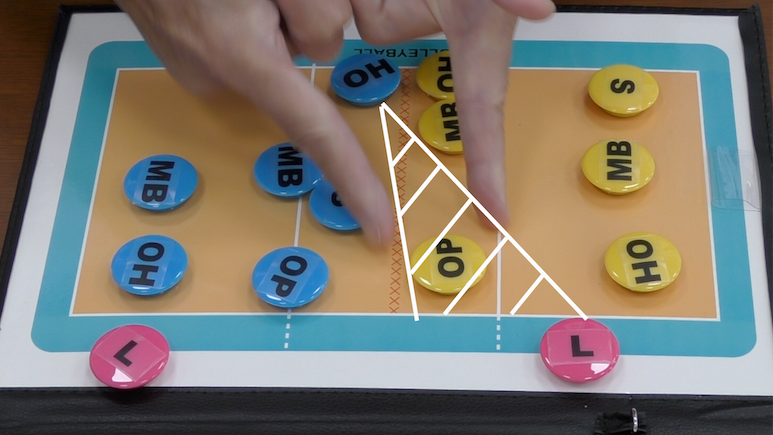
However, if this Middle Blocker (MB) goes to block the opponent’s quick attack and Block on the side of court is reduced to one player, then this MB is no longer in Block, so the opponent’s attack will come within this range. That will come here. And here. Also here.
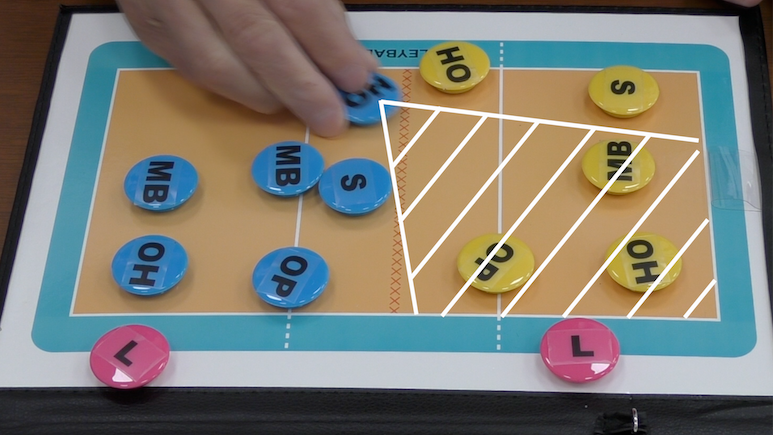
And at such times, when Block is reduced to one player, the Defensive team makes this kind of formation.
Q: Will they be side-by-side instead of fan shaped?
When this formation becomes a fan shape, when the opponent’s attack comes here, this player may go for Dig. This player may also go. And this player may go, so fan shaped formation will occur a risk.
So the current mainstream of the Team Defense in the world is, and when Block is only by one player. I am talking about the basic. Basically, make a Defense formation like there is a big mat here. Like this. Can you see? Like this.
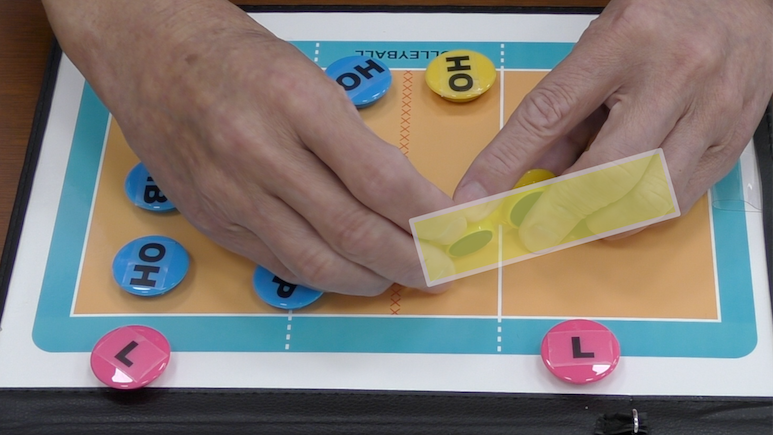
Then, whether Dig goes well or not, wherever the opponent’s attack goes, it will hit the Defender’s body.
For example, if MB goes to block the opponent’s fast attack first and this MB delays to go to the side of the court, and that leads to have a gap between Block, which means the opponent’s attack may come here. That may come to this course.
So if Defensive players will be allocated to the area the opponent’s attack may come, then aside from Digs going well or not, there will be fewer balls that fall to the court with no touch. That is why Defensive players will go enter the course where Block cannot cover. So it is important to make sure to do that.
So if Block is aligned by two players completely, only one Defensive player is required around here. Because the opponent’s attack comes out within this range. Then, as there is a possibility that a one-touch ball will come here, so this player has to be prepared for that by keeping a little bit backward position.
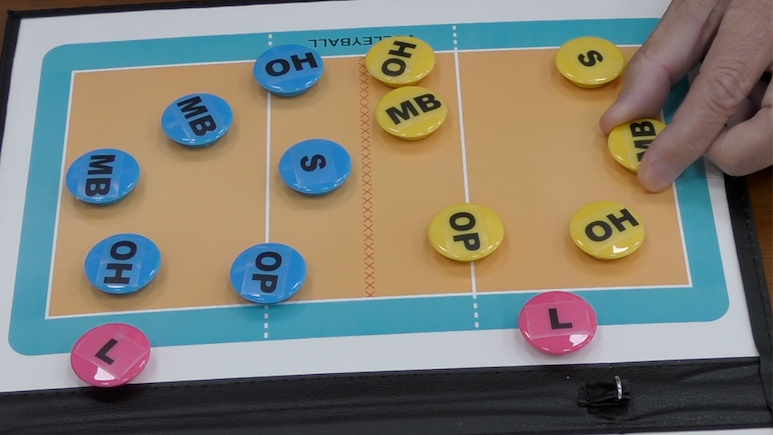
So this is the basic concept of Team Defense in these days. This is the current trend of World Volleyball.
So, for example, Back Row Attack often used by Japan national team. When Mr. Yuki ISHIKAWA or Mr. Ran TAKAHASHI enters into Back Row Attack, the opponent’s Block tends to be with one MB player.
*Mr. Yuki ISHIKAWA & Mr. Ran TAKAHASHI: Outside Hitters of Men’s Japan National Team, who participated in Paris Olympic.
That is why Back Row Attack will always go in this way or that way. And so Defensive players would get in these courses, but Back Row Attacks of Mr. ISHIKAWA and Mr. TAKAHASHI are quite fast and difficult to Dig. They go from the backward as strong as possible.
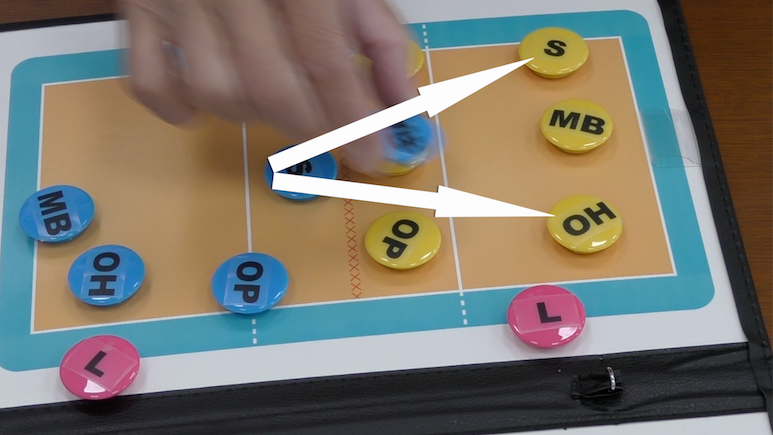
But there are teams that do not have Defenders in such courses where Back Row Attack will come. So, such teams are seen as not being able to do basic things.
So, team study the Data and find out the opponent’s players’ tendency of hitting the attack, and create the formation to make Digs better, so that they will allocate players to prepare the opponent’s attack and Dig them well. So, in Volleyball, Digs will be well with good preparation, and those will be bad in incorrect situation.
Part 7-2: Block with 3 playerク
Q: Is the way of thinking of Block with 3 players the same as that with 2 players?
Yes. Basically, Defensive players are allocated where the opponent’s attacks come. For example, if Block with three players is here, the opponent’s attack comes through very narrow range.
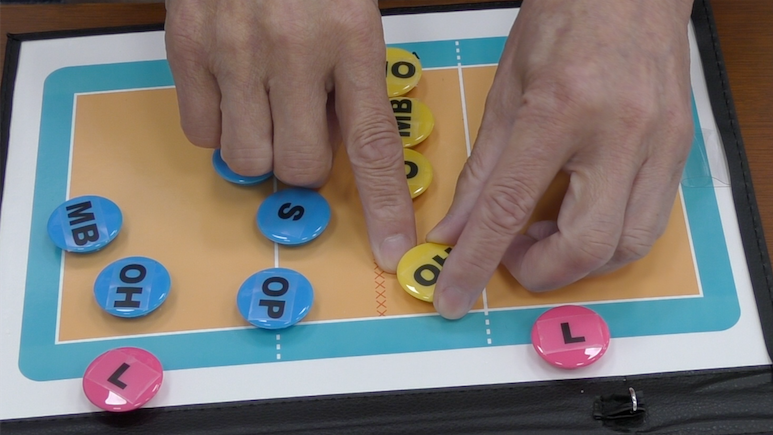
So, first option is to cover here. Or cover the opposite corner. And to have this player (=Middle Blocker: MB) prepare for deflected ball, so this Player (=Setter: S) for the covering a feint attack. Each team may have an internal arrangement.
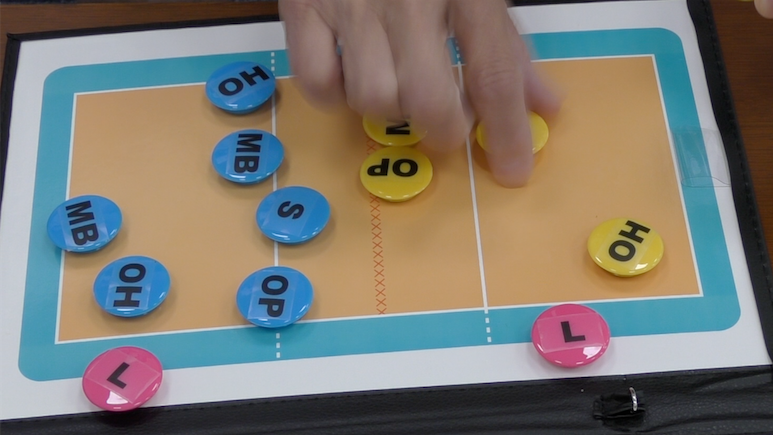
And when there is Block with three players, this Outside Hitter (OH) considers whether to aim scoring touched by Block or to hit the spike to the quite angular course. Or, if these are difficult, OH may consider to deliver the attack to the opposite corner over Block. Another option is feint attack. If there is no covering player here, OH also considers that he/she can deliver a feint attack here.
So Volleyball is very interesting when you look at it from such perspective.
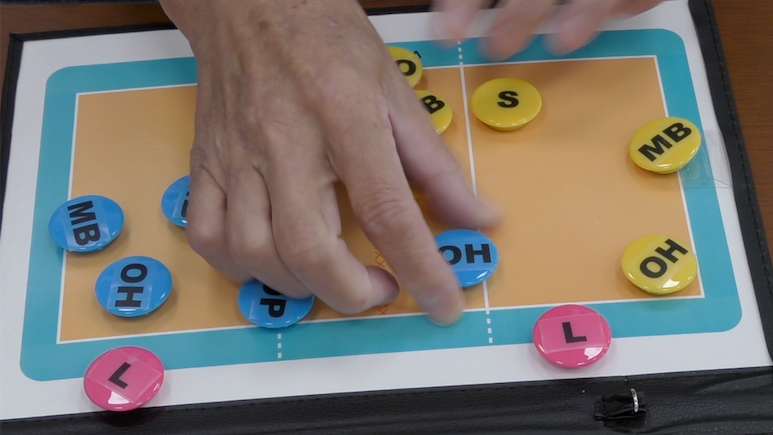
Q: If Block uses three players, that makes the rest players to cover larger area, right?
Correct. But when there is Block with three players in a row, the attacking player definitely does not like it. That is why the attacking player chooses feint attack or delivering attack to the opposite corner. So, for example, this player will cover the feint attack. Or this player will Dig feint attack.
Considering the risk and the merit of having Block with three players, the opponent’s attacker is under a lot of pressure, so the hard attacks and feint attacks definitely increase. So it is interesting such tactics of game.
Also, there are situations that the attacker considers that the opponent’s Block will be with two players, but this Opposite (OP) player works hard and joins as the third player and blocks the attack. Aren’t there? OH thinks the third blocking player does not come so OH hits the cross spike on the angular course, but the third player comes later and stops the attack by Block. That is one of the great things of Volleyball.
There are times that, “Oh, the third blocking player went and blocked it, albeit belatedly.” And the attacking player felt bitter that, “the third player didn’t come, but suddenly came later.” That is also the fun of Volleyball.
Part 7-3: Working hard
For example, this Opposite player (OP) hits a spike from the right side. This player (=MB) is late in joining into the block. So, MB is not in the block. Other players can take a Defensive formation like this.
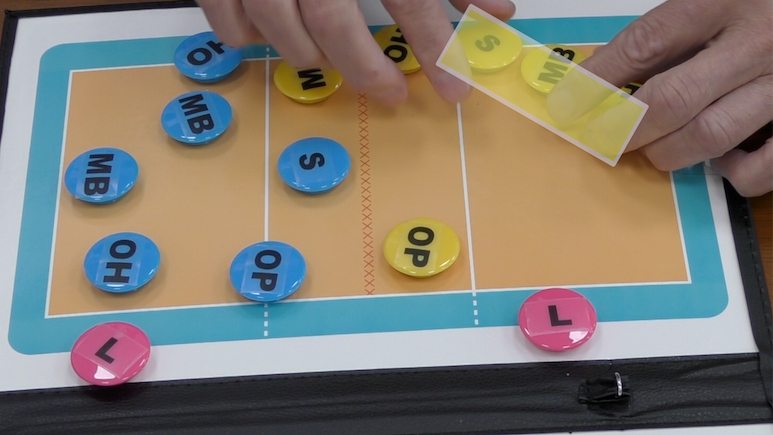
Considering the situation of block, for example, the opponent’s choice was quick attack and the block was composed by only one MB player. Thus, the opponent’s attack would come from both sides of the block. Then, players are required to take proper positions for each of them. This OP player should back once and join into the block again. They have to do such movement all the way.
When the attack is not successful and Rally goes on, players have to go for block again. And they have to step back for Dig. Teams that can firmly make such move, waiting for the opponent to attack properly, are the top level teams in the world.
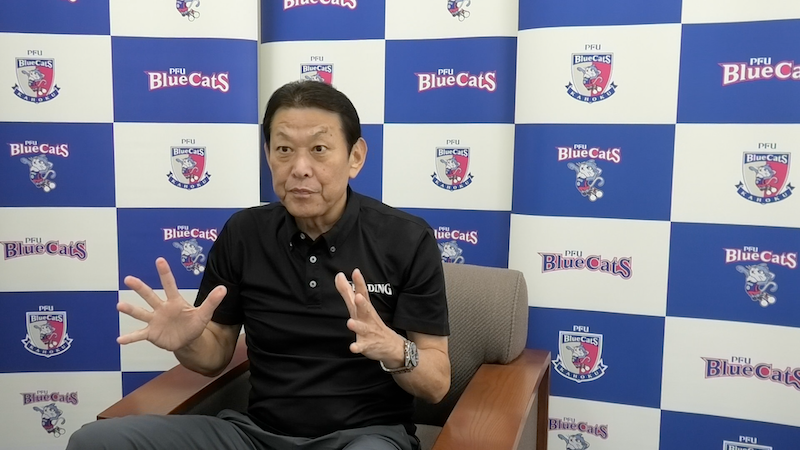
When watching Volleyball from such point of view, you can notice that players move like that. “Yes, they are doing that.” “Yes, they stepped back for Dig.”
“Oh, they could not make the proper formation, because the opponent’s attack was too fast.” So Volleyball players are required to work hard.
This MB player joined into the block. If blocking player touched once, MB must move back. Other players were composing the line of Defense like this. But they immediately return to the original positions.
Such hard working is very important. A team that can work hard quickly and firmly is definitely a strong team.
Q: If so, the longer Rally, the more tired players get?
They get tired. And then the game enters into an interval. But players’ breathing can never be recovered completely during such a short interval. So in Volleyball, teams with top leveled players and those players work hard are strong.
I would like to recommend to consider why blocking player can touch once. “Oh, one player came into block to help.”
I think French team is so great in the combination between Block and Defense. The movement of the Middle (Blocker = MB) is amazing. If you watch the sideway movement of MB and the height of Block, it is also amazing. Italy, France, and Poland are also great.
That is why Japan team chooses a fast “Parallel Set” and attacker comes quickly to the point such setting will delivered. Setter (S) sets such fast setting because the attacker comes there and hits a pinpoint fast attack. The opponent has to respond quickly to that speed. If you take this into consideration, Volleyball becomes more interesting.
And there are times when the data changes the positioning slightly. For example, the data shows that the opponent does not hit this way too much, so this MB should stay on the other side.
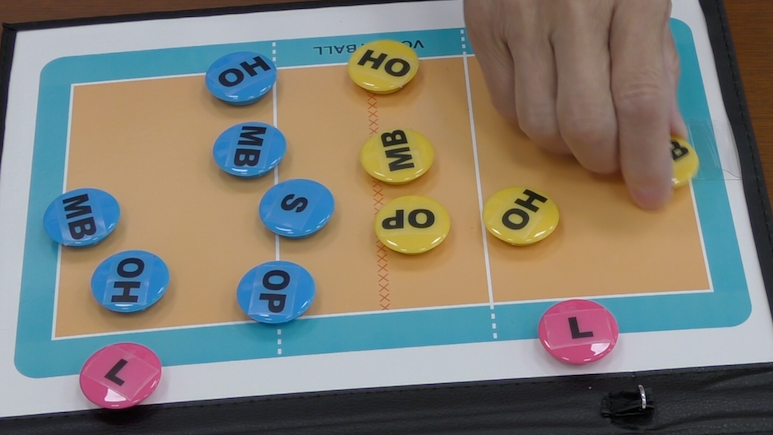
I think without a strong mental, players cannot work hard. So I think mental condition is the most important thing in the top level.
Part 7-4: Tactics on Block
Q: Kill Blocks are one of the best things of Volleyball, aren’t they?
As I myself was a player, so I would like to say that Kill Block is one of the most exciting plays in Volleyball. Rather than scoring point by Spike, I felt the best when I did Kill Block. Outside Hitters (OHs) are all about scoring points with attacks, aren’t they? So, shutting Attacks by them out is a great feeling. Therefore, when OHs, such as Mr. Yuki ISHIKAWA, who usually hit spikes, shut the opponent’s Attacks out by Block, they show that they are quite excited.
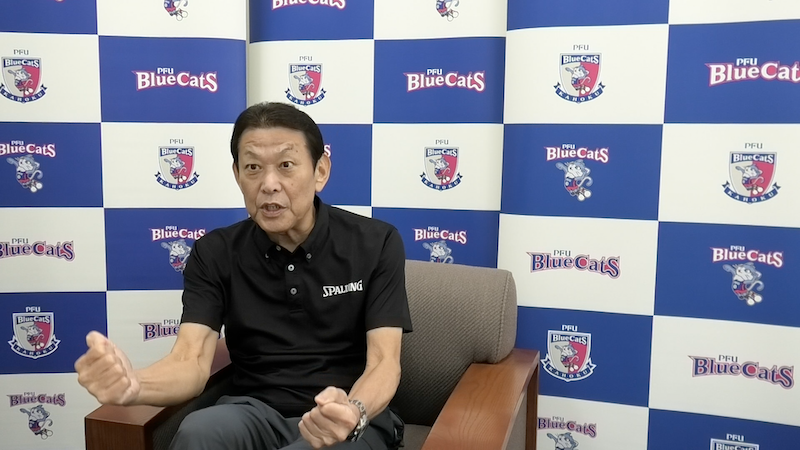
On the other hand, Middle Blocker (MB) consider that Block is already their job, so of course they are happy when they do Kill Block but they do not show their excitement out, however, OHs know their shock when they are being shut out, so they sometimes intimidate their opponents when they stop the opponent’s Attack completely.
And there will be, again, the battle of a kind of their mental states, the mental struggle between both teams. So Volleyball players have to be tough. They have to be tough.
Q: So the Defensive team decides where to make Block based on the attacker’s tendencies?
Yes. Correct. Then you prepare where to Block first. For example, (Mr. Yuki) ISHIKAWA most often hits his Attack on this course from the left side of the court. Then, the opponents prepare where to defend based on that.
Q: Sometimes, blocking players raise their hands diagonally in Blocking maneuver, right?
Right. But not so often. In the European teams. The reason is that when Blocking players are firmly aligned, they put their Blocking arms forward, so even the opponent’s Attacker hit the spike to the cross course, it will be shut by Block. Block is enough high even if they do not raise their hand diagonally.
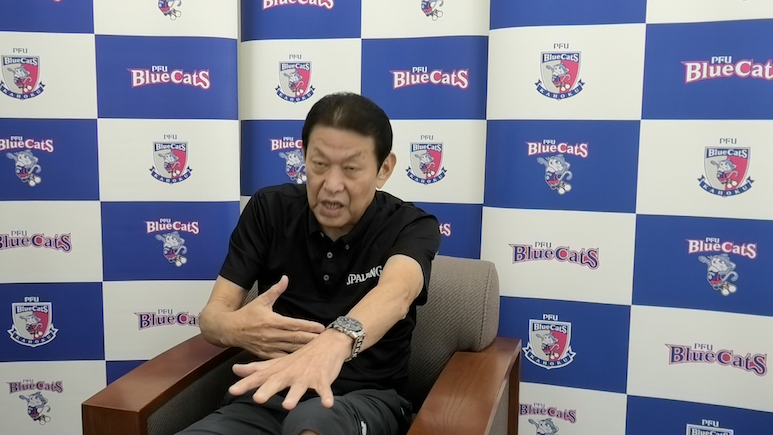
So, if the opponent’s Block is aligned with two players, even Mr. (Yuki) ISHIKAWA or Mr. (Ran) TAKAHASHI has the difficulty on successful on Attack. So for the Japanese Attackers, they want to hit the cross spike before MB has been joined in the Block. If the opponent’s Block has been completed, Attackers would aim to get touched by Block by hitting to straight course.
But if that does not seem to be possible, they would often try to get a rebound or hit over Block. So, if the opponent’s Block has been completed firmly with two players, Japan team’s Attack is tough. Yes, it is tough.
Q: Though Attacker is watching the opponent’s Block when he/she hits a spike, if Block is completed properly, the attack to be shut out?
That’s right. Attacker thought he/she hit the spike on the cross course properly, but Blocker’s arm came forward more than he/she expected and the spike was shut out. In such case, the ball shut out falls quite strongly to the court.
Q: The Japan team did Block with fists at the Paris Olympics?
I suppose that was developed by Mr. (Yuki) ISHIKAWA. Or maybe that has been often done recently. That was amazing, wasn’t it? He did well with that. At the Paris Olympics. I thought that was impressive.
But that has a risk, I think. But it might be better to Block by fists. If Blocker pulls the Blocking arm down, the opponent’s spike might come sharply to the court. If Blocker does not pull the arms down at the moment Attacker hits, Attacker will know there is no Block if pulling down is too early.
So that is also a tactic of the games. But that is the interest things of playing Volleyball, too.
Block tactic of Japan National Team
Q: Does Japan National Team mostly adopt “Commit Block” as a tactic?
As I mentioned, Japanese MB is a bit weak so sometimes adopting Commit Block. Other National teams do not adopt Commit Block anymore, almost. Like France and Italy. They almost always adopt Read Block.
*Read Block: a method of identifying where Setter (S) has delivered the setting and then blocking there.
If a team adopts Commit Block, the opponent can notice that easily, so the opponent’s Setter (S) will always delivers the setting up to both side of the court. Then there will be Block with only one player.
Q: In Commit Blocks, does blocking player commit to Outside Hitters (OH) or to Middle Blockers (MB)?
Basically, to MB is most. To commit to MB to hit the Quick Attack. So, Blocker prepares for Block prior to such Quick Attack. In other words, the situation in which Blocker jumps before the setting is delivered and waits the opponent’s Quick Attack is Commit Block.
But if so, MB can no longer join Block at the side of the court. Therefore, Block on the side will be with only one player. But Japan team tolerate that and make a Receiving formation now. They tolerate having only one player Block on the side. But that cannot be helped. It is a weakness of Japan.
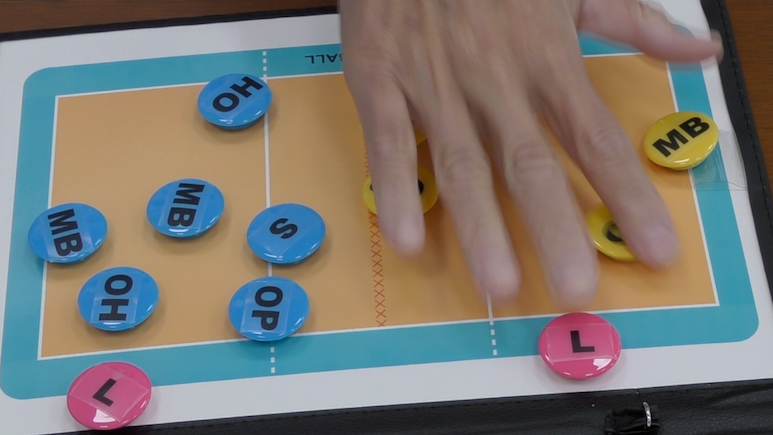
Q: Even though there would be Block with only one player at the side of the court, Defensive team tries to stop the opponent’s Quick Attack?
And to prepare Defensive formation firmly and to make Dig well is the aim. When the opponent’s Reception is quite well, the men’s Japan team often follows this pattern. Other countries of course know this. So I would have to say that Japan team also has some weaknesses. But even so, I think Japanese MB has much improved than before.
Share this content:
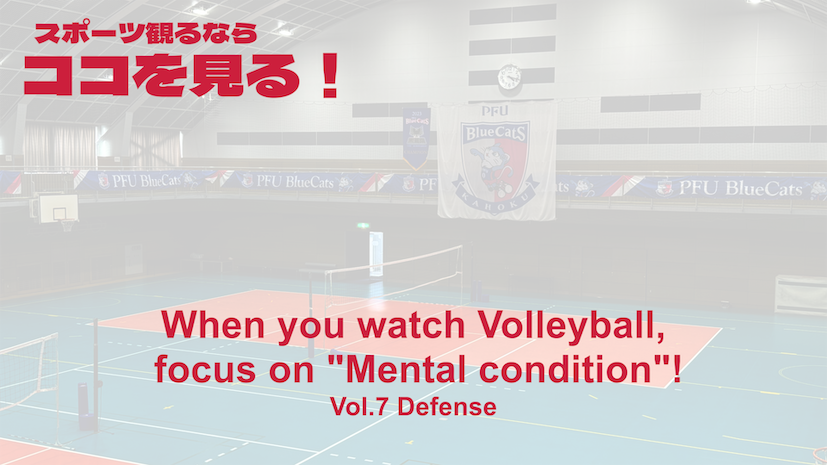
コメントを残す